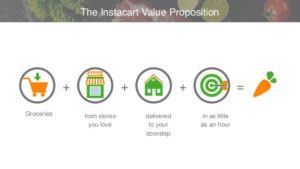Instacart – Crowd-sourcing Your Grocery Shopping with Just A Few Clicks

Instacart has changed customer’s grocery shopping experience by crowd-sourcing the tasks to personal shoppers. It has found ways to create value for customers, retailers as well as shoppers.
Grocery shopping can be tedious and challenging. Lugging heavy goods in paper bags that can break easily and enduring the incredibly long lines at stores just make you dislike shopping. Instacart seized the opportunity and created an on-demand service platform that has “personal shoppers” shop for groceries on behalf of customers and deliver to customers’ doorstep.
How does Instacart work?
Revenue Stream
Instacart gains revenue from three distinct sources – retail partners, customers as well as advertisers.

First, Instacart charges fee from retailors based on size of each basket. The company now has over 100 partnerships with grocery retailers around the country, including popular chains like Whole Foods, Costco and Safeway.
Second, Instacart charges customers in the form of delivery fees per order or annual subscription. The delivery fee, often starting at $5.99, depends on the size of the order and the delivery time that you choose. Customers can also subscribe the services at$ 149/year to get free deliveries and the flexibility to place order from multiple stores.
Third, the fastest growing source of revenue, according to COO Ravi Gupta, comes from advertisers that pay to reach out and advertise to Instacart customers. Instacart can surface ads of a particular company to selected group of target customers and provide analytics about how those ads performed.
Operating Model and Performance
The company operates under an asset-light model. It does not hold any inventories because all products are purchased at the retailors’. Instacart hires two type of employees – full-service shopper who are independent contractors and perform both shopping and delivery tasks, and part-time shoppers who shops only and work under flexible schedule.
Instacart has three primary costs per delivery – payments to shoppers, credit card transaction fees and insurance. Although Instacart does not disclose its financials, its revenue is estimated to hit nearly $600 million in 2016. It also claims to be unit-profitable in certain cities and gross margin positive.
Value Creation and Capturing
As a platform that connects customers with shoppers, retailers and advertisers, Instacart creates great value for each party involved.
First, Instacart saves customers a ton of time, energy and cost. They don’t need to drive or go to grocery stores themselves anymore. With just a simple click, they can place order for the items they want at any time to multiple retailers. It made gathering ingredients for last-minute meals possible.
Second, retailers benefit from increasing volume of orders and frequency of shopping. As grocery shopping becomes faster and more convenient, customers would likely place more orders at one time because they don’t need to worry about having to carry groceries back home. They will also shop more often at multiple stores, even at those that located far away.
Third, with Instacart, shoppers earn extra income in their spare time. They have the flexibility to choose the time slots that work for them and earn additional money at peak time.
With a simple approach, Instarcart captures value by creating it, stimulating demand from customers, driving sales for retailors and advertisers while creating extra income source for its personal shoppers.
Looking Ahead

Founded in 2012, Instacart is now a $3.4 billion grocery startup. In May 2017, it just raised $400 million from Sequoia Capita for market expansion and investment in technologies. However, it is now facing tough competition. E-commerce giant like Amazon is aggressively driving its Fresh and PrimeNow services. It also just opened its Amazon Go store to public, offering a seamless grab-and-go experience. How will grocery shopping experience change in the future? Will Instacart be able to scale quickly enough? What other services could Instacart offer to differentiate from competition?
Sources:
[1] https://www.bloomberg.com/news/articles/2017-03-08/instacart-now-400-million-richer-tries-to-be-thrifty
[2] http://www.businessinsider.com/instacart-is-profitable-but-only-under-these-circumstances-2016-3
[3] http://www.sramanamitra.com/2017/04/05/2017-ipo-prospects-instacart-getting-ready-to-deliver-on-the-stock-exchange/
[4] http://money.cnn.com/2017/03/08/technology/instacart-funding/index.html
[5] http://fortune.com/2016/03/24/instacart-profits/



After reading Amazon’s post, I also wanted to add a few thoughts. With Amazon GO store in the picture, how would grocery shopping experience be shaped would be a very interesting question. Looking back, grocery shopping has evolved from personally performing the task to outsourcing to someone else. I believe that in the future, the grocery shopping experience would be a mixture adopted by different customer segments. Less digital-savvy and price-sensitive customers would shop at traditional stores offering the lowest cost. Digital-savvy and busy working class would outsource the task. Grab-and-go system definitely streamlined the shopping experience by saving the time spent waiting in lines. But still customers need to go to the physical location of store and choose from limited offerings in the store. I wonder how much would the Go-like store replace the traditional retail store and which customer segment will be more easily to converted into Go store shoppers.
Thanks for a great post on a very interesting topic! I particularly appreciated your mention of freeing up users’ time – much like the Google Car purportedly attempts to do so, Instacart certainly has helped me create large chunks of otherwise relatively dead time. While they do not disclose their financials, would be very interested to learn just how much profit Instacart is taking home. Though it is asset light as described, between the fees to drivers and the seemingly thin upcharges on groceries, would be interesting to learn just how much profit they are able to hold on to, and how sustainable that model is. How defensible is their model in a world where big players – Amazon of course being perhaps the most notable – may just come in and defeat them. Certainly, has been exciting to see the tremendous amount of success they have created in a short period of time!